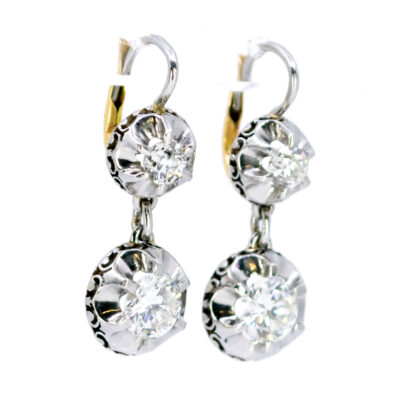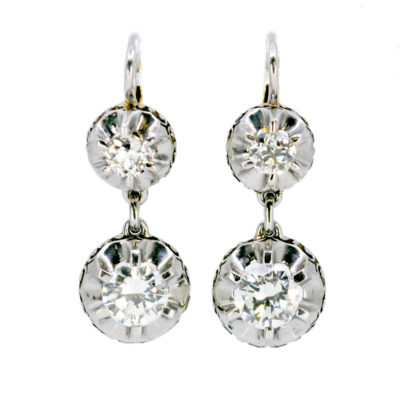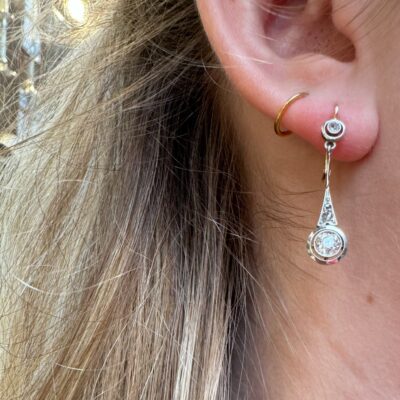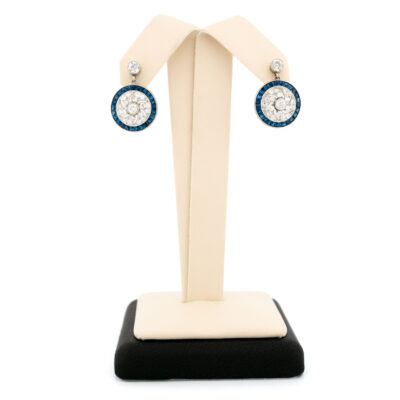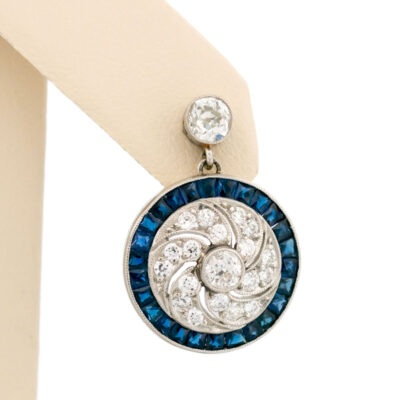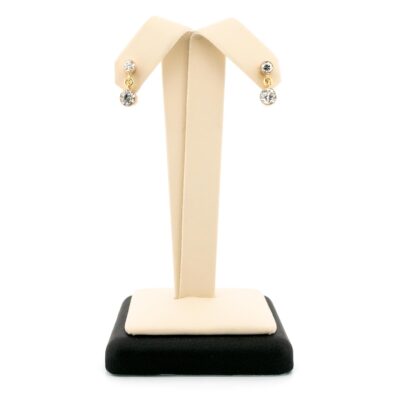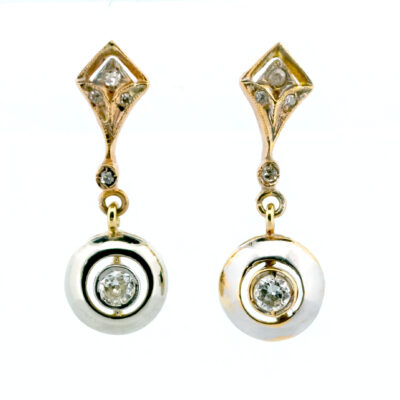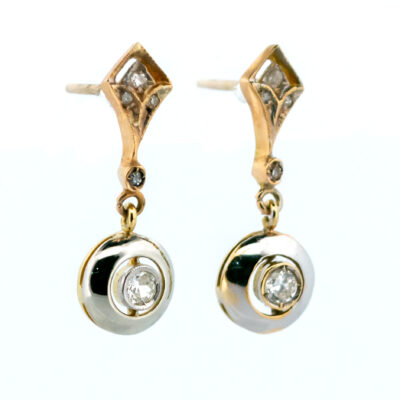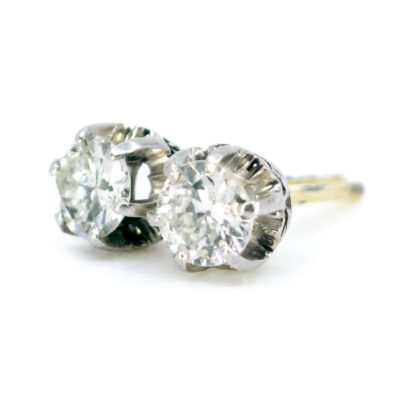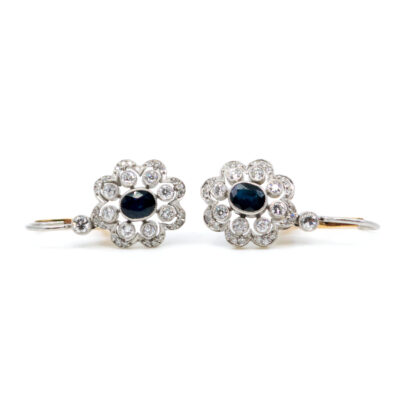These delightful vintage Art Deco-design pendant earrings feature oval-shaped sapphires with an estimated total weight of 5.25 carats, decorated with Old European Cut diamonds with an estimated total weight of 0.30 carats, graded H in color and SI1 in clarity. The earrings are crafted in a combination of yellow 14k gold and platinum.
Videos
Details: ±5.25ct Sapphires, ±0.30ct (H SI1) Old-european-cut diamonds, 10k Earrings.
Design Era: Vintage Art Deco.
Dimensions: H 1.6 x L 1 x W 0.5 cm.
Weight in grams: 4.3.
Condition: Excellent condition – barely used with minimal signs of wear.
Shipping and Pickup: This charming piece ships from our store located in the center of Amsterdam, The Netherlands. We offer both registered shipping and local pickup at our store. In the case of local pickup, any applicable shipping costs will be refunded.
About Us: Add some sparkle to your style with Binenbaum.com. We offer a stunning selection of antique and vintage jewelry that you won’t find anywhere else. From timeless rings and dazzling necklaces to unique brooches, we have something for every taste and occasion. Visit our website today and treat yourself to a piece of history.
| Design Era | |
|---|---|
| Design & Historical Context | Art Deco jewelry, also known as Jazz Age jewelry, became popular in the 1920s and remained in style through the 1930s. It was named after the Exposition International des Arts Décoratifs et Industriels Modernes, a exhibition held in Paris in 1925 that was largely dedicated to the jewelry arts. This style was inspired by a variety of cultural and artistic movements, such as Oriental, African, and South American art, as well as Cubism and Fauvism. Art Deco jewelry is known for its sharp, straight lines and emphasis on modernity and the machine age. During the Art Deco era, there were significant improvements in diamond cutting techniques, which made diamonds more radiant and sparkling than ever before. This, along with increased prosperity, allowed more people to afford diamond jewelry and engagement rings. Additionally, new casting techniques made it possible to produce more intricate and detailed settings. Art Deco jewelry was not only fashionable but also reflected the social and cultural changes of the time. The bold, modern design of Art Deco jewelry reflected the liberation and empowerment of women during the 1920s and 1930s. Today, Art Deco jewelry is highly sought after by collectors and is often featured in museum exhibitions and high-end auctions. |
| Key Materials | |
| Materials & Craftsmanship | Sapphire: The Gem of Wisdom and Royalty Sapphire, known for its stunning deep blue color, is a gemstone that embodies wisdom, loyalty, and nobility. This precious stone is a variety of the mineral corundum, and while blue is the most famous color, sapphires can also be found in a range of hues, including pink, yellow, green, and even colorless. Historically, sapphire has been revered across cultures for its association with the divine and the eternal. In ancient Persia, it was believed that the sky was painted blue by the reflection of sapphire stones. Throughout the ages, sapphire has been favored by royalty and clergy as a symbol of purity, virtue, and divine favor. Perhaps the most famous modern example is the sapphire engagement ring worn by Princess Diana and now by the Duchess of Cambridge. In jewelry, sapphire is celebrated for its beauty and durability, boasting a Mohs hardness of 9, second only to diamond. This makes sapphire an excellent choice for rings, necklaces, and earrings intended for everyday wear. The stone’s intense color and clarity are often highlighted by settings in white gold or platinum, though yellow gold can also enhance its warmth and depth. Sapphire is more than just a gemstone; it is a symbol of wisdom, fidelity, and nobility. Its rich history, combined with its remarkable durability and beauty, makes it a timeless and elegant choice for jewelry that signifies enduring love and commitment. Old-european-cut diamond: The Vintage Sparkle of Classic Romance Old European-cut diamonds are a beloved choice for those who appreciate vintage elegance and timeless beauty. This diamond cut, which was predominant from the late 19th century through the early 20th century, is known for its round shape, high crown, small table, and large, open culet. These characteristics give the stone a soft, romantic sparkle that evokes the charm of a bygone era. Historically, the Old European cut was the precursor to the modern round brilliant cut. It was crafted by hand, with each facet carefully shaped to maximize the diamond's brilliance under the softer lighting conditions of the time, such as candlelight. This cut was popular during the Victorian, Edwardian, and Art Deco periods, making it a favorite in antique and vintage jewelry. In modern jewelry, Old European-cut diamonds are highly sought after for their unique sparkle and historical significance. They often exhibit a warmer, more subdued brilliance compared to modern cuts, with an emphasis on depth and fire rather than the bright flashes of light seen in contemporary diamonds. This makes them ideal for engagement rings, earrings, and other pieces that celebrate vintage style and craftsmanship. An Old European-cut diamond is more than just a gemstone; it is a piece of history, reflecting the elegance and romance of the past. Its distinctive charm and enduring beauty make it a perfect choice for those who appreciate the artistry and nostalgia of vintage jewelry. 10k: The Practical and Stylish Choice with a Durable 10k Golden Hue 10k gold is a popular alloy used in jewelry, containing 41.7% pure gold and 58.3% other metals such as copper, silver, nickel, or zinc. This combination makes 10k gold a practical and affordable choice for those seeking the allure of gold while balancing cost and durability. Historical Context: Modern Jewelry Appeal: Color and Finishes: Yellow Gold: Offers a warm, subtle golden tone, although not as rich or intense as higher karat yellow gold. White Gold: Often rhodium-plated to enhance its white, silvery appearance, making it similar to platinum or sterling silver. Rose Gold: Features a pinkish hue achieved by adding copper, providing a romantic and stylish look. 10k gold is versatile and can be used in a wide range of jewelry designs. It pairs well with various gemstones and materials, allowing for a broad spectrum of styles from classic and elegant to modern and trendy. The metal’s affordability also allows for more experimentation with designs and settings. Metaphysical and Practical Considerations: 10k gold is more than just an economical choice; it represents a practical balance between cost and durability, offering a stylish and versatile option for everyday jewelry. Its affordability, combined with its golden hue and strength, makes it a valuable choice for those seeking the classic beauty of gold in a more accessible form. Whether chosen for its practicality or its elegant appearance, 10k gold provides a solid and attractive option for any jewelry collection. |
| Dimensions | H 1.6 x L 1 x W 0.5 cm |
| Gender | |
| Weight (in grams) | 4.3 |
| Condition | Excellent condition – barely used with minimal signs of wear |
By following these tips, you can enjoy your precious jewelry for many years to come.
Related Products
-
Diamond Platinum 18k Pendant Earrings 8597-2074
€ 8.795,00 VAT incl. (where applicable) -
Diamond 18k Pendant Earrings 16002-2459
€ 4.995,00 VAT incl. (where applicable) -
Diamond Sapphire Platinum Dangle Stud Earrings 14259-2425
€ 5.995,00 VAT incl. (where applicable) -
Diamond 14k Pendant Earrings 12342-2343
€ 5.395,00 VAT incl. (where applicable) -
Diamond Moonstone 14k Platinum Dormeuse Earrings 12718-8005
€ 1.295,00 VAT incl. (where applicable) -
Diamond 18k Platinum Deco Earrings 10530-6626
€ 1.495,00 VAT incl. (where applicable) -
Diamond Platinum 18k Stud Earrings 9470-6206
€ 3.695,00 VAT incl. (where applicable) -
Diamond Sapphire Platinum 14k Earrings 8601-2078
€ 5.295,00 VAT incl. (where applicable)
- Home
- Collection
- Fine Jewelry
- Silver Jewelry
- Silverware
- Boxes
- Candlesticks
- Salt and pepper shakers
- Miniatures
- Salt cellars
- Spoon Set
- Condiments
- Frames
- Napkin Ring
- Spoon
- Oddities
- Cups
- Vases
- Cutlery
- Serving Spoon And Cake Server
- Candlesticks
- Baskets
- Hanukkiah
- Spice Tower
- Yad
- Tea Set
- Sugar Castor
- Napkin Rings
- Wine Bottle Coaster
- Wine Stopper
- Tea Pot
- Jugs
- Rattles
- Hip Flask
- Miscellaneous
- Rings 💍
- About
- Contact
- No products in the cart.




